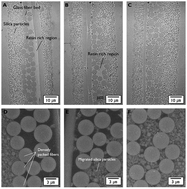Forced infiltration of silica beads into densely-packed glass fibre beds for thin composite laminates†
Abstract
Along with the advancement of miniaturized mobile devices, packaging technology requires the utmost high-performance of thin composite laminates in terms of material properties such as the coefficient of thermal expansion (CTE) and stiffness. These two properties have been improved by the incorporating of secondary fillers (e.g., nano-sized silica beads) into the densely-packed glass fibre beds in the composite laminates. However, the secondary fillers are hardly impregnated, but usually filtered out by the fibrous bed, giving a poor distribution of the fillers. In this study, we used ultrasonication at a specific range of frequencies and time to induce bubble implosion and microjetting, which could repulse the adjacent fibres, desirably creating interstitial spaces for the secondary filler particles to move into through the densely-packed fibrous bed. The migrated secondary fillers facilitated stress transfer among the beads and fibres, and subsequently altered the thermo-mechanical properties to a great extent. More specifically, the coefficient of thermal expansion (CTE) was greatly decreased by the ultrasonication from 9.8 ppm K−1 to 6.1 ppm K−1 (by 38%) at 25 °C, and from 20.6 ppm K−1 to 15.8 ppm K−1 (by about 23%) at 175 °C. The storage modulus was increased from 7.3 GPa to 9.0 GPa (by 23%) at 40 °C. There achievements are thought to be critical improvements in the development of high performance micropackaging devices. Anisotropic ultrasonication was demonstrated as a driving force for the cooperative distribution of thermo-mechanical stresses through the bulk movement of densely-packed fibres and nanoparticles.


 Please wait while we load your content...
Please wait while we load your content...